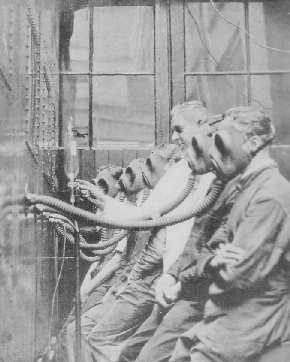The cost of world armament in 1913, when the nations of Europe knew that war was imminent, was $2,531,000,000; the cost for 1929 was $4,300,000,000; it is estimated that the 1936 cost will approach $10,000,000,000. Never has the world witnessed such intensive armament activity as in this day of universal nervous tension. The immediate mobilization strength of Europe is approximately 55,000,000 well-trained, modernly equipped soldiers, distributed as follows:
SOVIET RUSSIA: Available for immediate mobilization: 16,980,000—Red (Regular) Army: 1,300,000; Reserves: 15,680,000; air strength, estimated: 4,000 planes. Defense budget for 1936: 14,800,000,000 rubles.
The Red Army is the greatest in the world. It is modernized, well trained, efficiently officered, and completely equipped.
Suspicious both of Nazi Germany and of Japan, the Russian government is preparing for a conflict, feverishly fortifying Vladivostok and Bira-Bidjan, and is building a chain of strong fortifications about the Japanese controlled state of Manchukuo.
GERMANY: Mobilization strength, estimated: 6,700,000—Regular Army: 600,000, as announced by Chancellor Hitler early in 1935; Reserves: 6,100,000; air strength, estimated: between 2,000 and 3,000 planes, the goal being 6,000, by 1937.
Military airdromes are concealed in strategic positions throughout the country. Germany has perfected an anti-aircraft gun with five revolving barrels, capable of firing 12,000 rounds per minute at a range of two miles. The Germans have also perfected the world's most accurate and reliable "predictor," involving both sight and sound, which will locate a plane or group of planes, even though they are invisible, and record their exact number and location.
AUSTRIA: Available for immediate mobilization, estimated: 1,500,000—Regular Army (limited by Treaty of St. Germain): 30,000; Reserves, comprising private military groups: 1,520,000.
Encouraged by Hitler's repudiation of the armament clause of the Versailles Treaty, Austria has announced plans for enlarging the national army to 65,000 actives, and has stated that it will no longer respect treaty restrictions.
FRANCE: Available for immediate mobilization: 7,049,963—Regular Army: 684,000; Reserves: 6,365,963; air strength, 4,600 planes. Defense budget for 1936: $800,000,000. However, the total expenditure for improvements planned will probably amount to $1,300,000,000.
Across her eastern frontier, France has constructed a barrier of shell-proof and gas-proof armored concrete redoubts only one thousand yards apart. Behind this rampart stretches a chain of citadels at Metz, Toul, Verdun, and Strasbourg. This is known as the steel girdle. The borders of France are well fortified, prepared for any emergency. Entire sections of the mountains have been hollowed out for subterranean encampments, supply depots, and electric rail-ways. Here it is possible to maneuver huge armies in complete secrecy and safety.
GREAT BRITAIN: While the immediate mobilization strength is officially 624,974, some authorities believe that Great Britain has between one and two million men ready to fill the ranks—Regular Army: 228,362; Reserves 396,612; air strength: 3,600 planes. Defense budget for 1936: £512,701,600.
An aviation project has been started which will provide a 300 mile line of airdromes for planes intended to combat hostile forces flying across the North Sea.
The strength of Great Britain, "The Mistress of the Seas," has always been her navy. In case of war this great, thoroughly modernized navy, with its airplanes, airplane carriers and anti-aircraft guns is prepared not only to protect the shores of Great Britain from attack by land or sea or air, but to carry on an offensive war.
ITALY: Available for immediate mobilization: 8,000,000—Regular Army: 437,368; Reserves: 7,562,632; air strength: 2,500 planes.
POLAND: Available for immediate mobilization: 2,047,035—Regular Army: 325,456; Reserves: 1,721,579.
BELGIUM: Available for immediate mobilization. 667,848—Regular Army: 67,848; Reserves: 600,000.
Belgium is constructing strong border fortifications from the Alps to the North Sea.
SWITZERLAND: Available for immediate mobilization: 630,094 —Regular Army: 494; Reserves: 629,600.
THE BALKAN STATES: Available for immediate mobilization: 4,902,706—56,000 in Bulgaria: 583,450 in
 |
FACING DEATH DAILY |
| These British soldiers are testing the effectiveness of masks against various poisonous fumes. The civilians of the British Isles are being equipped for protection. |
THE SCANDINAVIAN STATES: Available for immediate mobilization: 1,433,500—74,900 in Denmark, 330,100 in Norway: 1,028,500 in Sweden.
SPAIN AND PORTUGAL: Available for immediate mobilization: 2,972,872—660,000 in Portugal; 2,312,872 in Spain.
HUNGARY: Available for immediate mobilization: 70,000—Regular Army: 35,000; Reserves: 35,000.
JAPAN: Available for immediate mobilization: 2,310,000—Regular Army: 248,000; Reserves: 2,062,000. Its potential strength is estimated at 4,000,000. Air strength, estimated: 3,000 planes. Defense budget for 1936: $882,300,000.